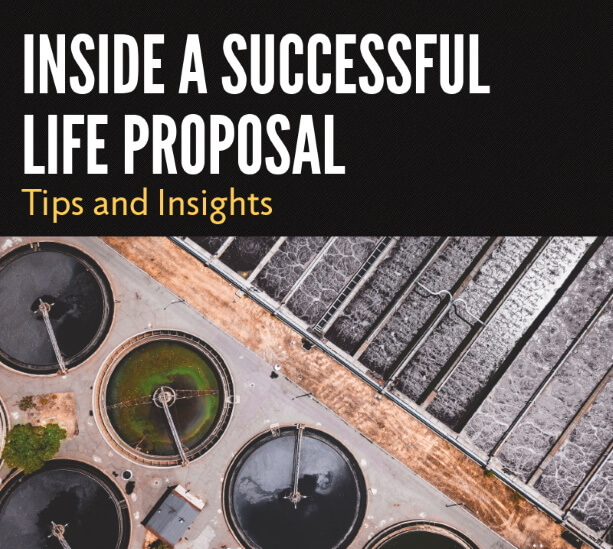
How much time will you need to prepare a successful LIFE Proposal? How do you find the best partners? Can the NCP (National Contact Point) be of any use to you?
This is the third article in a short series, which will allow us to dive into the preparation of a successful LIFE Proposal. In this article, LIFE AMIA explains how they applied for their Environment project.
Can you briefly describe your project?
LIFE AMIA is a demonstration project that aims to reuse wastewater in agricultural irrigation and aquifer recharge to protect aquatic environment against pollution caused by pathogens and micropollutants not removed by conventional wastewater treatment plants (WWTP), at significantly reduced energy requirements. To this end a novel process consisting of an anaerobic-aerobic compact treatment, a microalgae raceway and a combination of adsorption and advanced oxidation process (AOP) will be validated. The new concept of WWTP will recover nutrients (algae) and reduce the net energy consumption and consequently reduce the emissions of greenhouse gases (GHG) by means of:
- Anaerobic treatment that produces biogas and consumes less energy.
- Microalgae treatment with low energy requirements.
- Adsorption & Electroxidation technology supplied by renewable energy.
How long did it take you to prepare the full proposal?
The proposal writing period for the full proposal was about two months, though not the whole writing team was working fulltime at all times. Several people worked on the proposal, mainly the coordinator and the Working Package (WP) leaders. To note that the two month writing period was relatively short and this was possible as some material from a previously submitted proposal was used. The concept note took about one month to prepare.
How did you find your project partners?
The project team had cooperated on projects together in the past. Initially contacts were made through references done by organisations that both Atlantis Environment & Innovation (Cypriot project partner) and the project coordinator had worked with in the past.
To note that we (Atlantis Environment & Innovation) maintain a large network of cooperating organisations. This network has been built through participation in numerous projects in the past 15 years. These organisations often invite us to participate in projects where organisations that are new to us also participate, so the network gradually grows.
Did you reach out to your NCP for any support?
We submitted the Concept Note to the NCP for comments. The comments were very useful and were taken into consideration when finalizing the Concept Note.
What are your 3 lessons for future applicants?
- The project idea and the EU added value it can produce are vital to the success of the project. It is thus necessary to know the state of the art and baseline conditions of the field in question very well, so that a useful and innovative idea can be built. Of course you need to put skill and time in the proposal to demonstrate all the above.
- Start the proposal well in advance so enough time is given to communicating and coordinating the activities, timewise and workwise, between all WP. It is important for all activities to connect smoothly and for all the deliverables to clearly contribute towards the overall goals of the project.
- A main issue to resolve early on is the budget allocation strategy. The budget should be allocated to actions and not to partners. Whatever corresponds to each partner based on the actions of the proposal is what they should get. A rough estimate of the budget split should be prepared by experienced staff early on and good communication between partners will minimize problems in the later stages.
Find out more about the LIFE AMIA project here.
Read more insights from LIFE-WithVulturesCY, Organiko LIFE+ and RELIONMED-LIFE projects.
To find out if your idea could be funded under the LIFE Programme contact us today. To keep reading our articles subscribe to our newsletter.


